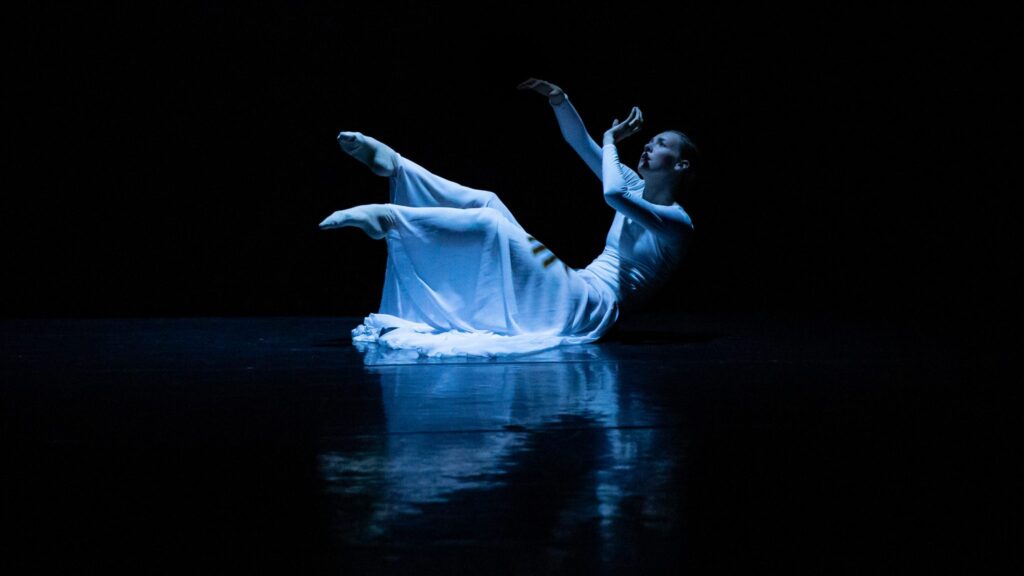“…an emotionally touching story on the universal trials of ephemeral change inherent to the human body”

review by Zachary Mann
A blackened screen is met with a set of hesitant piano strikes, underpinned by the low hum of a cello as the performance begins. Body of Words fades in with a gentle glow, then transitions to a quote from Ballet Edmonton’s Artistic Director: “We celebrate the community who listens and bears witness to everything we offer them.”
What follows is a heart wrenching combination of dance, music, and poetry which explores the “challenges in living in a continually changing and temperamental body”.
Body of Words is a part of the SkirtsAfire festival, a 10-day program which ran in conjunction with International Women’s Day to support the development of female-identifying and non-binary artists dedicated to pursuing a career in the arts. It is comprised of six installations, three spoken word poetry performances from Medgine Mathurin and Nisha Patel and three dances by Ballet Edmonton choreographed by Karissa Barry. The performance ran online from March 7-14 on the SkirtsAfire website for a minimum payment of $10.
The first performance opens in a small room with walls covered by black curtains. The scene is lit with a single white light which shines down on spoken word artist Medgine Mathurin. She lets out a sigh and begins with the words “Dear Stranger”.
“They cut and pasted parts of you on that new poster, I saw it. And when I told them, they said that you were old news,” she says to herself.
Her speech is emphatic, allowing each word to ring unique to every other word. However, the poetry does not stop at the word, as this expressiveness can also be seen in both her facial expressions and body language. Movement is used as emphasis in this piece, much like everyday dialogue, which creates a more intimate setting between the poet and her audience. At times it looks as if Mathurin is wincing at the expulsion of the lines, as if the simple act of uttering the words causes her pain.
“Dear Stranger,” she says, “They yelled trade in the stocks of your new pigment to cash in privilege and so many bought it.”
Poignant would best describe this piece, built from the torment felt from an imposed societal identity which strips away at self-identity. But even through this torment, Mathurin finds a sliver of solace in knowing that the make-up of her personal identity can never be stripped away (“After all that I’ve put you through, you are skeleton in my closet. But you are the only one that fits me perfectly.”).
The scene then transitions to an empty ballet studio bathed in pale blue and white light. The beginning of “Odchodząc” by Grzegorz Ciechowski (arranged and performed here by pianist Hania Rani and cellist Dobrawa Czocher) plays as dancers Paula Cobo Botello and Bryce Taylor enter from either side of the frame – Bryce Taylor wears a forest green top and navy-blue trousers, Paula wears the inverse of his colours. Each dancer focuses their movement through their right hand, and each hand starts to dance around the other, coming into close contact but never quite meeting each other face to face. The movements of the hands quickly augment to incorporate the bodies of the dancers but keeps the choreography of the hands, dancing around each other while incapable of direct confrontation.
An arrangement for cell and piano is used in Body of Words
The piece feels anxious. The dancers use the stage to its full extent, never remaining in place for long. Their execution, however, remains in consistent control, never looking forced. Moreover, the camera moves with the dancers. This keeps the dancers in the centre of the frame for a more enjoyable viewing experience and allows the audience to feel as if they are taking part in the dance rather than simply observing it.
The third performance returns to the curtained room but has exchanged Medgine Mathurin for Nisha Patel, Edmonton’s Poet Laureate. Her poem “In the Aftermath of the Poisoned Lung, which did not Heal and Does not get Better” contrasts with Mathurin’s first performance in that it seeks to show that an ever-changing body can itself be as much a crucible as the body’s interactions with the external world can be.
“Some days I wake, and I forget that I am not a childhood bedroom, places filled with space to store my memories of the days where I could inhale an entire ocean without wanting to drown,” she says.
This poem is an arduous journey through temptations of death, which is echoed by the laborious rhythm of speech – kept at a quick and steady tempo throughout the entirety of the reading. While this rhythm may serve to enhance the affectation of the poem, it also makes it difficult to register what Patel is attempting to convey at times, requiring multiple listens to understand the poem in its entirety.
A solo routine carried out by Yoko Kanomata follows Nisha Patel. The stage is saturated with blue light, contrasting the much lighter tones of the first dance, and uses the same music (“Odchodząc”) as before, but starts at the point of which the music from the first dance ends. There is a disparity in the choreography of this piece. Unflustered pirouettes and placid poses are mixed between a series of chaotic thrashes from the upper body – which are noticeably stifled when compared to their more tranquil counterparts.
It emanates the feeling of being trapped. At one point, Yoko even violently shakes back and forth as if she were drowning. Moreover, the dance works particularly well when considering the performance it follows, acting as an additional comment on, or a way of understanding the content of, Nisha Patel’s spoken word poetry.
“I know I don’t look sick,” says Medgine Mathurin, “but there is a riot beneath my skin, and I am having trouble articulating its treason.” The final spoken word performance sheds light on the trials of living with chronic health conditions. Just like her previous performance, Mathurin gently guides her audience through the grief becoming of a body working against its owner.
“How do you love a body accustomed to playing riddles? How do you answer a body who makes a mockery of the Jesus you were taught that heals a body who can be too loud for me to remember God’s mercies in the morning?”
The loss of faith felt through the torments a body may ask its owner to endure builds upon the feelings of constriction from the previous performances. But even in these times of torment, Mathurin speaks of the catharsis found in their purging.
“I will weep as necessary because to stifle my lamentations is to betray the cleansing that is necessary for my joy to bloom,” she says.
The poem finds a way to work past the trials found in itself and previous performances, or at least a glimmer of hope that these trials may eventually pass. Once Mathurin finishes, the screen fades to a quote from Walt Whiteman: “And your very flesh shall be a great poem.”
The third and final duet with Diego Ramalho and Ariana Barr marks the finale of the performance. The blue has been flushed out of the stage and is replaced with a more welcoming orange. The music starts again where it left off in the previous dance. The dancers approach each other more confidently than in the last duet, signifying a greater willingness to partake in the dance with their partner.
This rings true throughout the performance – the dancers move with each other rather than away from each other and the lifts are handled with greater care, are held for longer, and reach greater heights than formerly seen. The interplay between hands has also been modified, finally meeting each other face to face and showing a desire to grasp the other’s body rather than stay separate. The performance ends as the camera closes in on the dancers’ hands as they hover inches away from each other.
The choreography, poetry, and music composed by Ciechowski all work together to create a poignant yet thoroughly enjoyable performance art piece. Each successive performance both builds and branches out from the preceding pieces, creating a cohesive set of diverse views on “the challenges in living in a continually changing and temperamental body.” The dances are well executed, and the poetry pieces are well-rehearsed, only letting through a few minor hiccoughs in speech.
The only thing I found particularly dissatisfying of an otherwise well-produced piece is the run-time. The piece runs for roughly 17 minutes, which is quite short. Regardless, Body of Words offers a unique combination of art forms which successfully harmonise to create an emotionally touching story on the universal trials of ephemeral change inherent to the human body.
Body of Words
SkirtsAfire Festival
March 7-14


